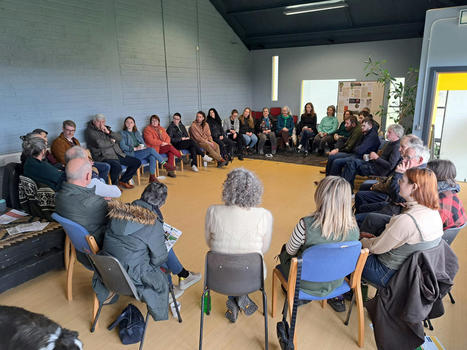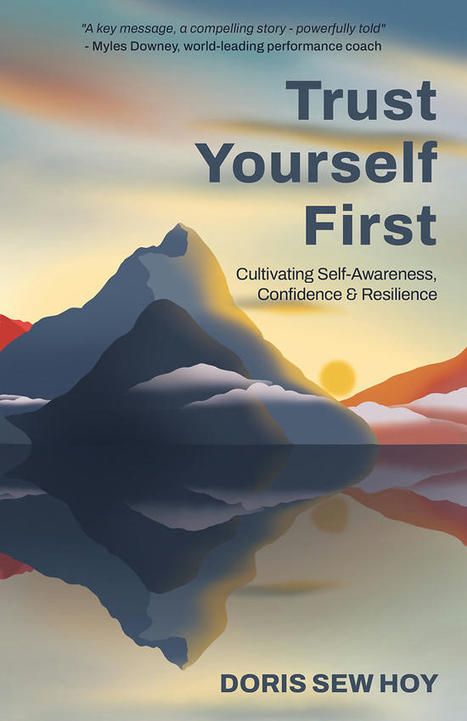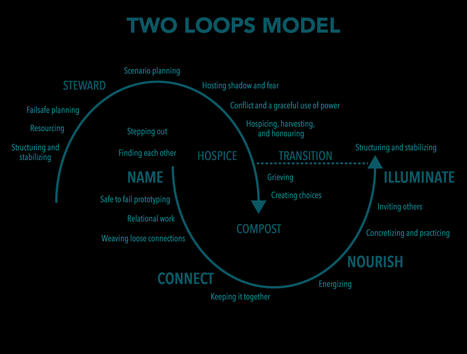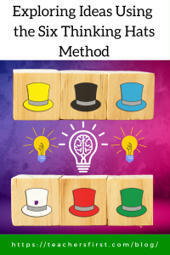 Your new post is loading...
 Your new post is loading...

|
Scooped by
F. Thunus
|
Sometimes things are simple and sometimes they are complicated. In the Irish midlands, from 21-24th March, people representing dozens of organisations involved in agri-food, came together to work together on how we feed ourselves. here's sever things I learned at this year's event.

|
Scooped by
F. Thunus
|
How do you define efficiency and effectiveness? And how can you help your team achieve both? Read on to find out.

|
Scooped by
F. Thunus
|
"Conducting a meeting gives us the opportunity to share ideas and information, collaborate and contribute with our coworkers and address important issues and goals." ...

|
Scooped by
F. Thunus
|
Over the last two years, I have been on a journey towards certification as a professional coach. My current coaching approach is naturally informed by Positive Psychology and utilizes various underlying theories and evidence-based interventions.

|
Scooped by
F. Thunus
|
Meeting customer expectations while keeping stakeholder’s interests in tact is important. This is why businesses need to be strategic and forward-thinking when forming a design strategy.

|
Scooped by
F. Thunus
|
Give these positive psychology tips a try to see if you can reclaim your zest for life! It may take a while, but it won’t hurt anything!

|
Scooped by
F. Thunus
|

|
Scooped by
F. Thunus
|
In this post, the first in a series I intend to write, I try to demystify the Action Reflection Learning Planning Framework. This is a very useful approach to help learn, avoid mistakes, and get better at implementing anything.

|
Scooped by
F. Thunus
|
Doris Sew Hoy is a New Zealand-born Chinese accredited career, leadership and executive coach based in the UK. She works with her clients to facilitate a deeper appreciation of their authentic selves, with the mindset and behaviours to get what they want to have happen.

|
Scooped by
F. Thunus
|
This book describes 15 practical applications of Human Complexity in the context of software and digital products development. And suggests a new strategy for introducing Complexity thinking to your team and your organisation.

|
Scooped by
F. Thunus
|
We collaborate with you to identify existing strengths and needs, to devise and deliver a plan to help achieve your intended outcomes. Our team provides blended learning opportunities to meet all time scales and budgets: consultancy; e-Learning CPD; training; coaching; action learning sets; programmes; supervision/s, towards introducing, consolidating and embedding restorative and relational practice.

|
Scooped by
F. Thunus
|
What are the most important life skills? How should we navigate work, survive challenges, and thrive in our relationships?

|
Scooped by
F. Thunus
|
I spoke to over one hundred heads of leadership development, and the common challenge is getting busy, overwhelmed employees to actually sign-up, show up, and participate in learning and development (L&D) offerings.
|

|
Scooped by
F. Thunus
|
David is Top 200 Global Employee Engagement Thought Leader, and Managing Partner at Diversity Advantage LLC...

|
Scooped by
F. Thunus
|
In need of organizational, personal and climate change? Alone we can do little, but together we can do a lot. Check what you can do and how you can start small and persevere until more people join in.

|
Scooped by
F. Thunus
|
It occured to me this morning after I posted that piece on affordances last night, I haven’t really blogged about the two loops model of change in living systems.That’s kind of a surpr…...

|
Scooped by
F. Thunus
|
Sometimes, studying is hard and requires a lot of focus and effort. That's why we compiled a list of the best apps to help you with time management, inspiration, and productivity. Read on and enjoy learning!

|
Scooped by
F. Thunus
|
Átl’ka7tsem, the fjord in which I live, in a photo I took in November 2014 The National Day for Truth and Reconciliation is coming up in Canada.Every person in Canada lives in a place that, …...

|
Scooped by
F. Thunus
|
Listening effectively is a key ingredient in leadership success, demonstrating to others that they're valued and understood, building trust and commitment, and in this blog we share our three top tips for developing your listening skills.

|
Scooped by
F. Thunus
|
Inclusive facilitation results in more effective and equitable ways of fostering social change work.

|
Scooped by
F. Thunus
|

|
Scooped by
F. Thunus
|
The Routledge Handbook of Collective Intelligence for Democracy and Governance explores the concepts, methodologies, and implications of collective intelligence...

|
Scooped by
F. Thunus
|
Title: Creative Expression and GTD As a Herbanaut, understanding the connection between productivity and creativity is essential. In this episode of the Change Your Game with GTD podcast, Todd Brown and Robert Peake discuss the intersection between productivity and self-expression.

|
Scooped by
F. Thunus
|
Great ideas need landing gear as well as wings. C. D. Jackson Every March, International Ideas Month takes place. This observation recognizes the potential of ideas, even those that seem simple or unattainable. As educators, we both teach students about famous people who have formulated great ideas and inspire them to explore their own. Coming up with an idea might be easy, but developing and turning ideas into reality takes more time. One way to help students think outside the box and analyze their ideas is to provide them with strategies for looking at their ideas through different lenses. One technique to consider is the Six Hats Thinking Method, which is helpful for many deliberative processes, including decision-making and problem-solving. In this method, students explore ideas and information by putting on six different colored hats, each connected to a different perspective. Let’s use the example of a student’s idea of eliminating homework to explore how to use the Six Hats Method. Although there isn’t a set order for using the hats in the thinking process, the white hat is a helpful starting point in this scenario. White Hat – Develop facts and information. The student starts gathering data related to their idea using a form or polling tool, then shares the results. This data collection includes simple questions, such as whether the respondent agrees that homework should be eliminated. Information-gathering tools: Microsoft Forms (reviewed here), Google Forms (reviewed here), or Poll Maker (reviewed here) Red Hat – Evaluate feelings and instincts. The student looks at their gut feelings and observes reactions from other students, teachers, parents, and administrators. The student gathers information to learn how strongly others feel about this issue and use it as a guide to understanding viewpoints other than their own. Tools to gather feelings: Classroom Screen (reviewed here) allows you to launch a quick poll where participants use emojis to record how they feel about eliminating homework. Flip (reviewed here) allows students to create and share a topic where interested parties can share their feelings about eliminating homework. Yellow Hat – What are the positives of this idea? The students brainstorm why this is a good idea and what positive effects it will have on the class. Tools for displaying positives: Canva for Education (reviewed here) has several ready-to-use pro/con templates like this one to help students share their ideas on eliminating homework. Use Google Slides (reviewed here) or Powerpoint (reviewed here) to create a slide for positive effects and another for the negatives. Black Hat – What are the negatives of this idea? The student gathers and displays perspectives on why eliminating homework is bad using the same tools discussed above with the yellow hat technique. Green Hat – Creativity and brainstorming. After considering all of the different perspectives, the student provides suggestions for implementing their vision and gathers input from others. Tools for brainstorming and creativity: TeachersFirst Edge: Concept Maps/Mind Maps has many free resources for creating and sharing ideas. Mindmaps (reviewed here) is an easy-to-use option that allows you to add ideas and edit colors to help visualize suggestions. For example, use one color for student-generated ideas, another for parent suggestions, and another for faculty ideas. Other concept map generators include options for collaboration, adding images and links, and more. Blue Hat – Reaching and sharing conclusions. After considering the many different viewpoints and coming to a decision, the blue hat helps students embrace rationality and provide conclusions. This is where your student shares the process they followed to reach a conclusion about the value of eliminating homework. Tools for presenting: Genially (reviewed here) offers several templates for creating interactive images and presentations. Create an interactive image that links to information gathered through the Six Thinking Hats Method. Managing all of the different perspectives and viewpoints is crucial to successfully considering ideas. IdeaBoardz (reviewed here) has a ready-to-use whiteboard template students can use to organize and share all of the information gathered. Click Create to start a board, then select Six Thinking Hats as the format, then click + to add information to the six areas labeled for each hat. Students can share their board’s URL to collaborate with others or include it in their finished projects, or save it as a PDF or Excel file. In addition to the exploration of student’s ideas, the Six Thinking Hats model is excellent for many other classroom uses and doesn’t always require the use of all six colors as part of the discussion: Assign a different colored hat to each group of students to use when comparing and contrasting characters’ actions in stories. Discuss events leading up to the American Civil War or the World Wars. Discuss the influence of social media on students. Use a single hat, such as the green hat, for creativity in math class and challenge students to find new methods to solve problems. Choose one or two hats as part of a role-playing scenario when solving classroom disputes. International Ideas Month is an opportunity for us to embrace new ideas and encourage students to share them. Using methods such as Six Hats provides students with a framework that includes both the wings and landing gear for exploring ideas and reaching well-thought-out conclusions. How do you inspire students to bring their ideas to life? How do you use the Six Hats Method in your classroom? We would love to hear your thoughts and suggestions in the comments below.

|
Scooped by
F. Thunus
|
Welcome to The Write Question, I’m Daphne Gray-Grant. Today we’re talking about how to improve thinking......
|
 Your new post is loading...
Your new post is loading...
 Your new post is loading...
Your new post is loading...













![Living Complexity by Luca Minudel [Leanpub PDF/iPad/Kindle] | Art of Hosting | Scoop.it](https://img.scoop.it/btTBHHhn-QSXuUzluo8GHzl72eJkfbmt4t8yenImKBVvK0kTmF0xjctABnaLJIm9)

















